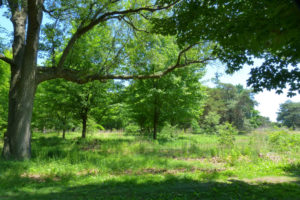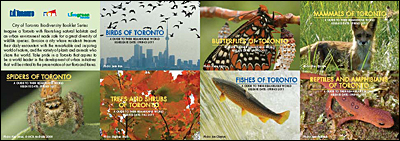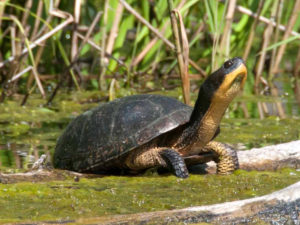 Toronto is fortunate to have substantial remnants of centuries-old natural habitats right in the middle of our urban environment. Many of these special places are found in our extensive ravine systems and close to the shoreline of Lake Ontario. These habitats include shady forests, sunny oak savannahs, sand dunes and marshy wetlands. They support a surprising diversity of plant and animal life.
Toronto is fortunate to have substantial remnants of centuries-old natural habitats right in the middle of our urban environment. Many of these special places are found in our extensive ravine systems and close to the shoreline of Lake Ontario. These habitats include shady forests, sunny oak savannahs, sand dunes and marshy wetlands. They support a surprising diversity of plant and animal life.
Many vulnerable species such as wood duck, wood thrush, wild lupine and Blanding’s turtle still survive here. During spring and fall migration these natural habitats provide a much-needed stopover point for many song birds and waterfowl.
See also: Natural Heritage Maps and Toronto’s Environmentally Significant Areas Map
Toronto’s Biodiversity
 The Toronto Biodiversity Series highlights some of the remarkable biodiversity that still exists within our city. We all share a responsibility to protect and care for this natural heritage and preserve it for its own sake and as a legacy for future generations of Torontonians to enjoy. With the city rapid pace of intensification, preserving valuable natural areas and their ecological integrity is critical for our vision of sustainable city to remain viable. Learn more…
The Toronto Biodiversity Series highlights some of the remarkable biodiversity that still exists within our city. We all share a responsibility to protect and care for this natural heritage and preserve it for its own sake and as a legacy for future generations of Torontonians to enjoy. With the city rapid pace of intensification, preserving valuable natural areas and their ecological integrity is critical for our vision of sustainable city to remain viable. Learn more…
See also: Wild, Connected and Diverse: A Biodiversity Strategy for Toronto and Agenda History, 2019
Legal Protection
 Many of Toronto’s special natural areas are identified as Environmentally Significant Areas (ESAs) in Toronto’s Official Plan. Some are also designated as provincially significant Areas of Natural and Scientific Interest (ANSIs) or Provincially Significant Wetlands (PSWs). These areas have been given special protected status to preserve their environmentally significant qualities:
Many of Toronto’s special natural areas are identified as Environmentally Significant Areas (ESAs) in Toronto’s Official Plan. Some are also designated as provincially significant Areas of Natural and Scientific Interest (ANSIs) or Provincially Significant Wetlands (PSWs). These areas have been given special protected status to preserve their environmentally significant qualities:
- ESAs are protected by the Official Plan and zoning and by the Ravine and Natural Feature Protection By-law; other City bylaws set rules for responsible use of parks, trails and ravines
- ANSIs and PSWs are protected under the Provincial Policy Statement and Natural Heritage Reference Manual guideline
- Wildlife are also protected by legislation such as the Migratory Birds Convention Act and Species at Risk Act (Canada), and the Fish and Wildlife Protection Act and Endangered Species Act (Ontario)
To be truly effective, this framework of legal protection needs to be supported by careful planning and management, public education and meaningful enforcement.
Municipal Bylaws and Naturalized Gardens – Presentation and links from Lorraine Johnson
See also:

